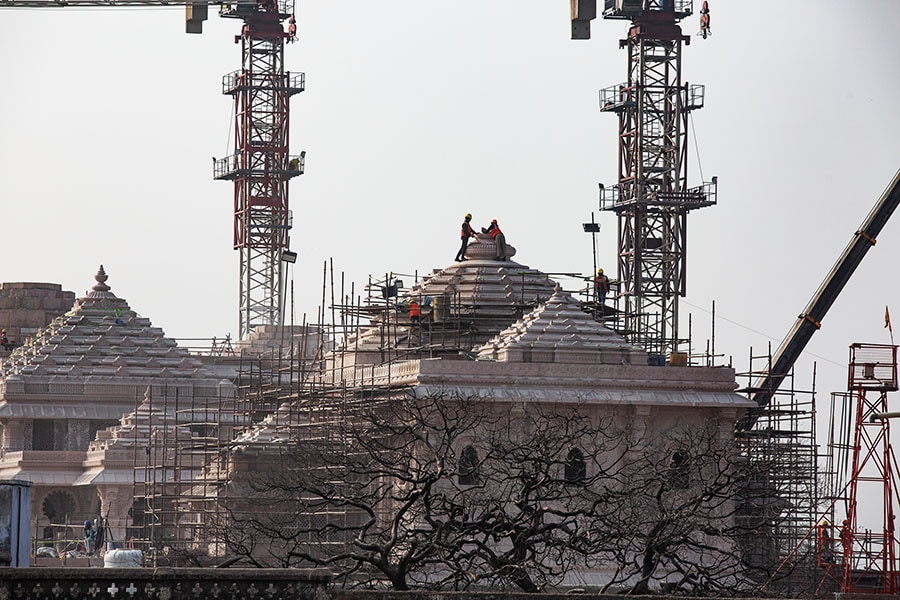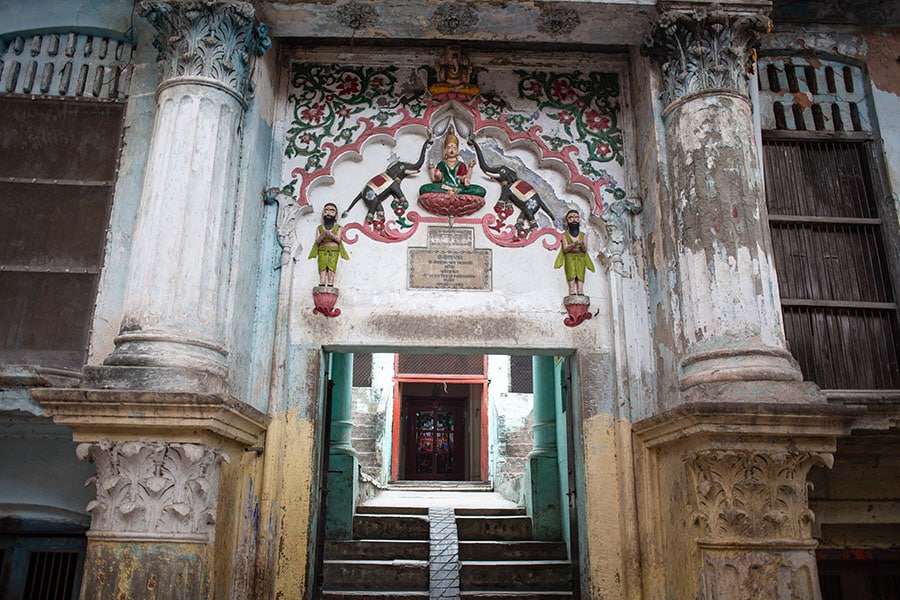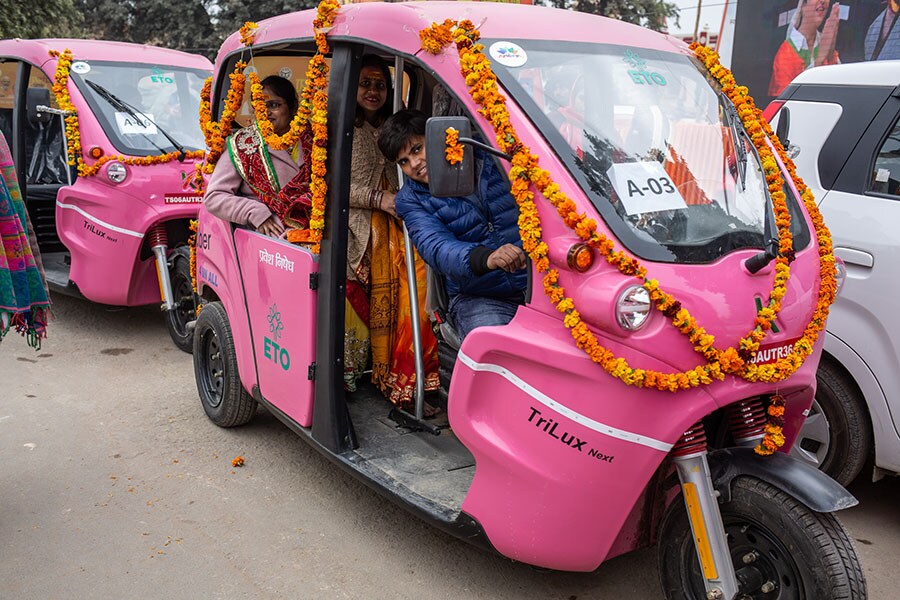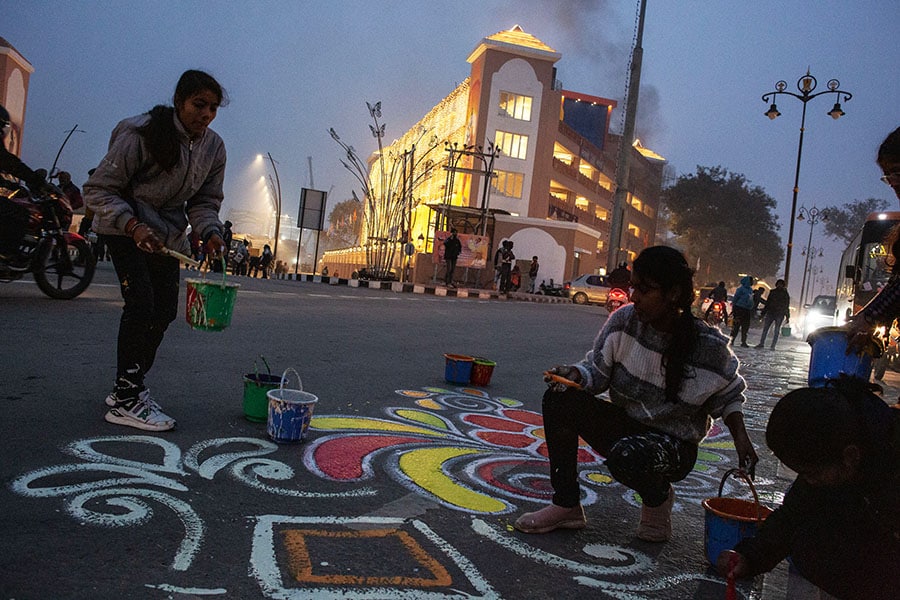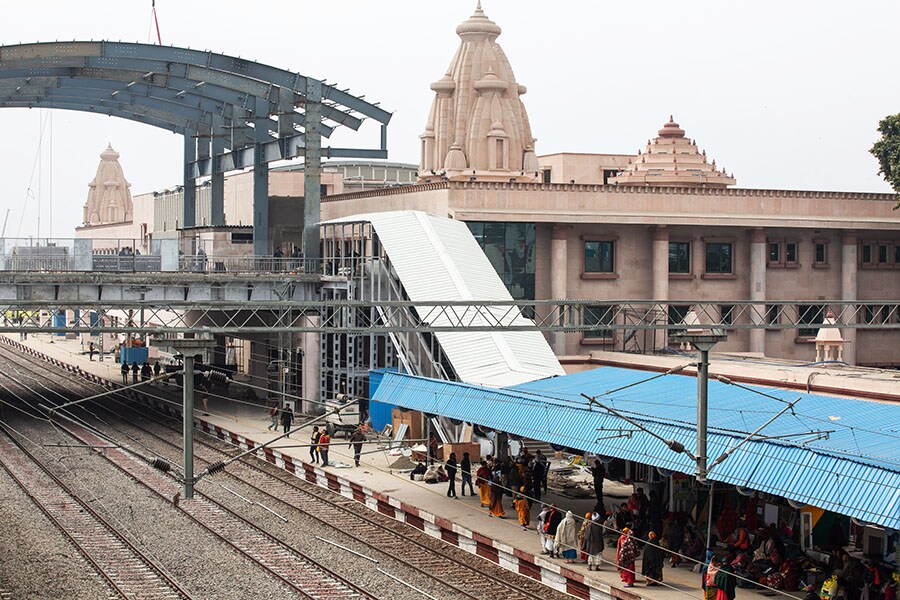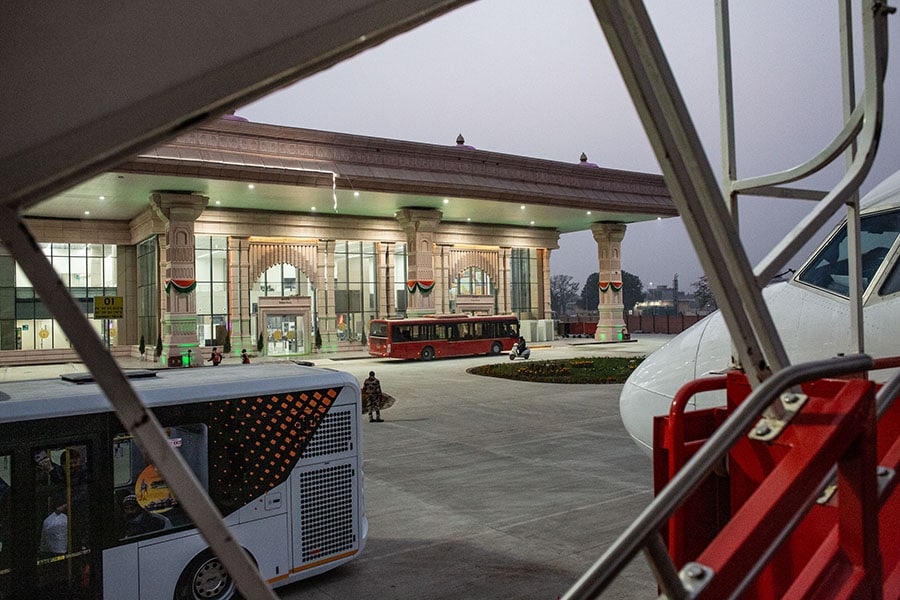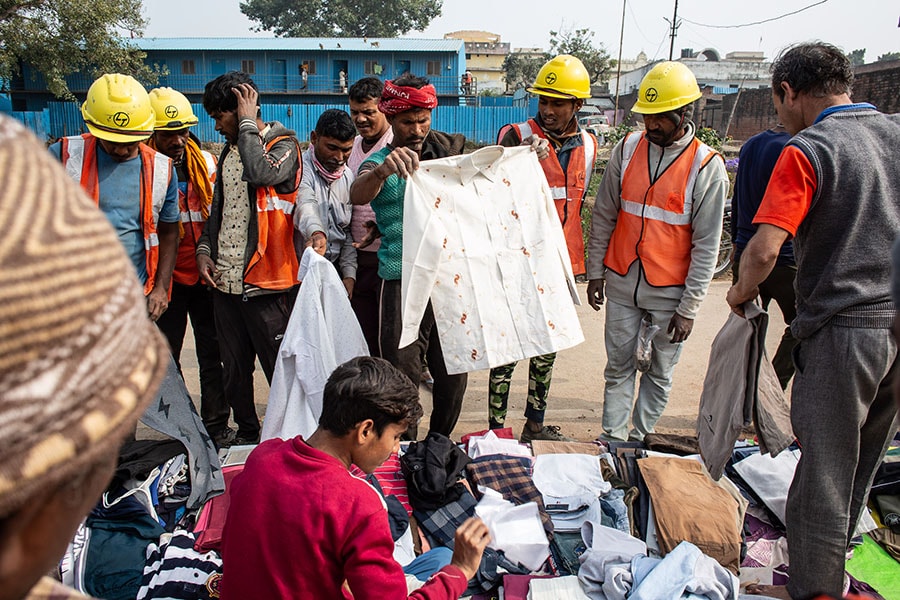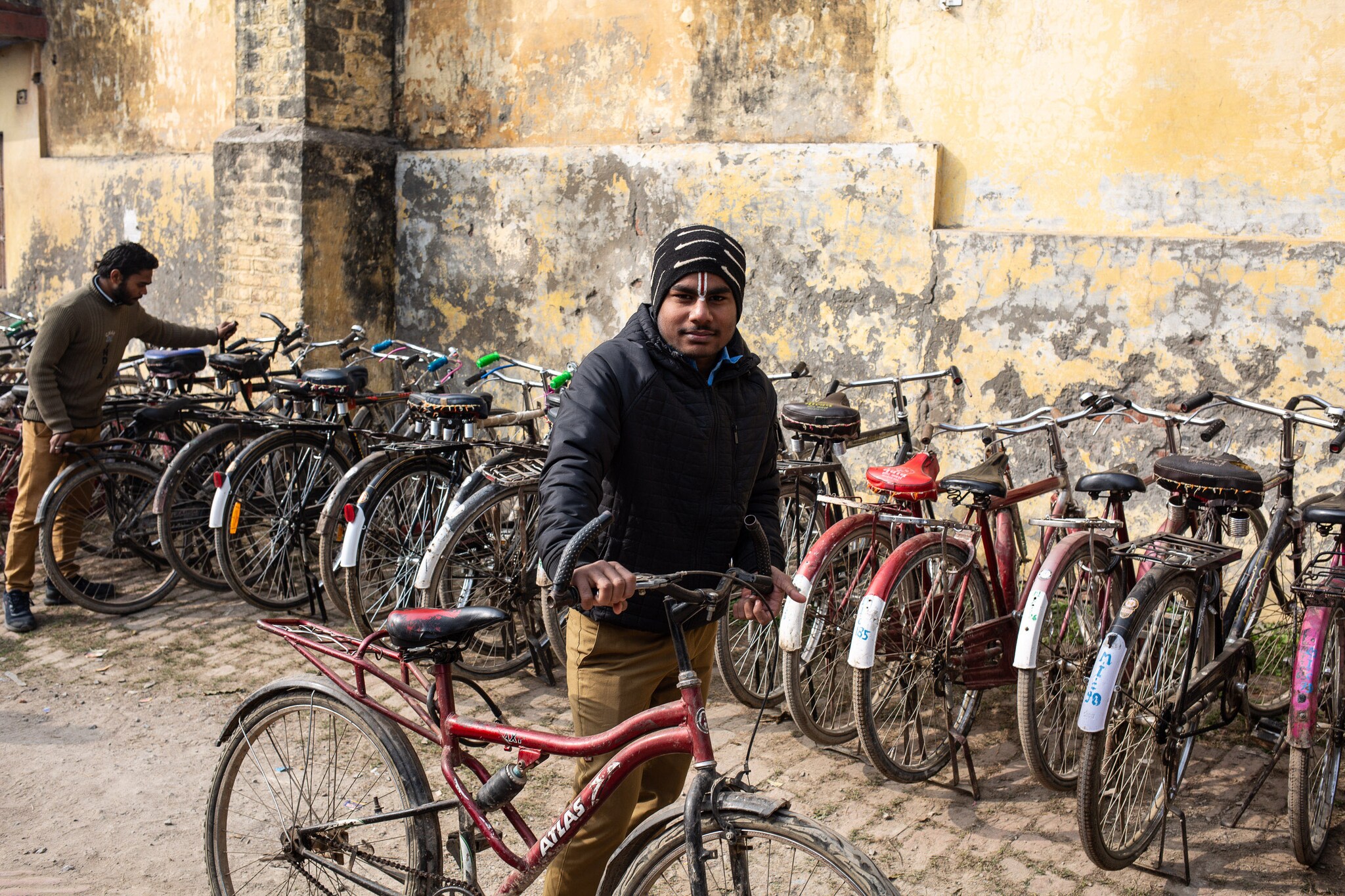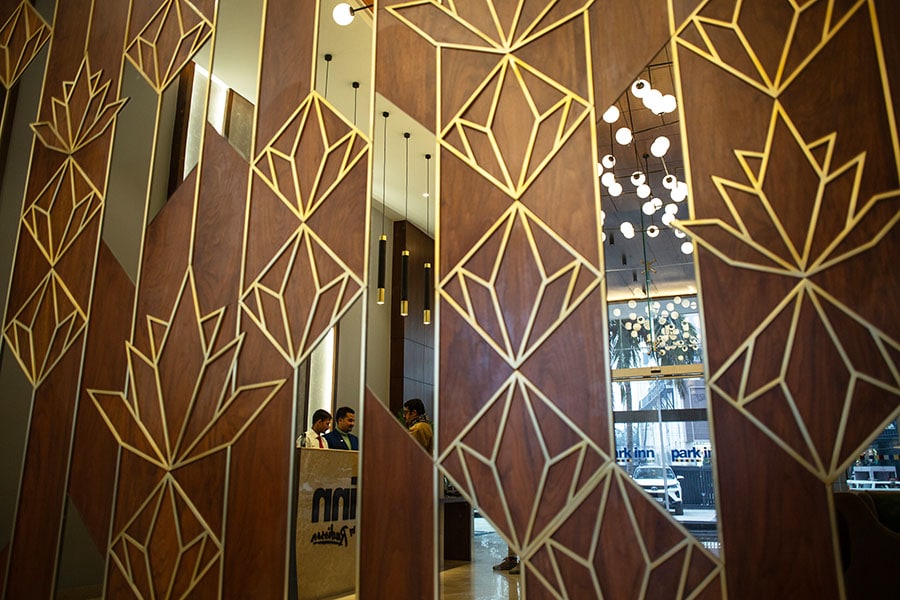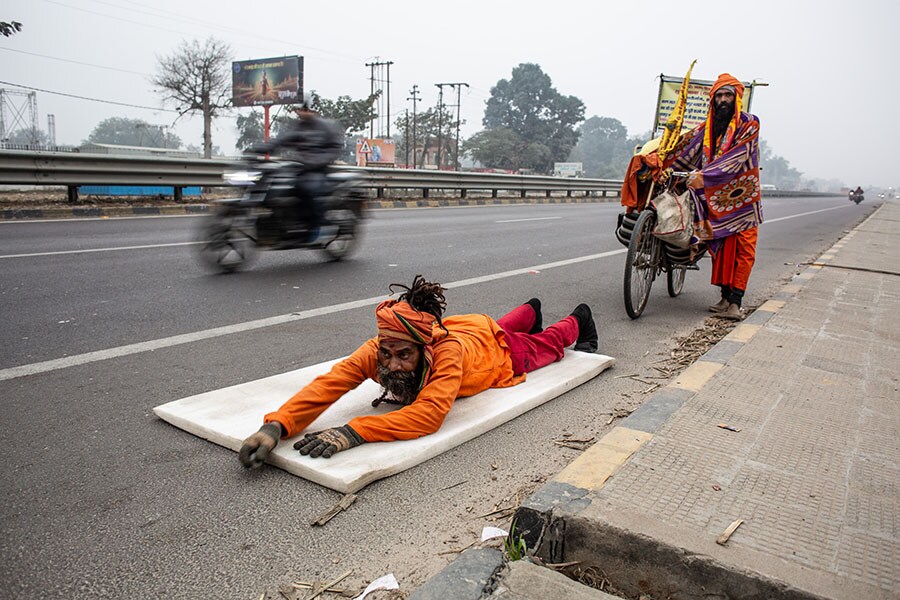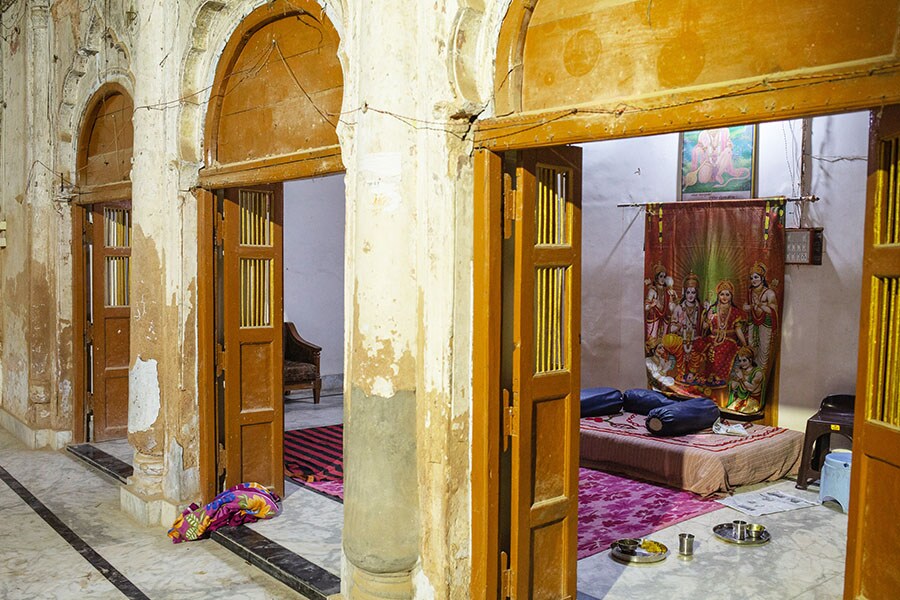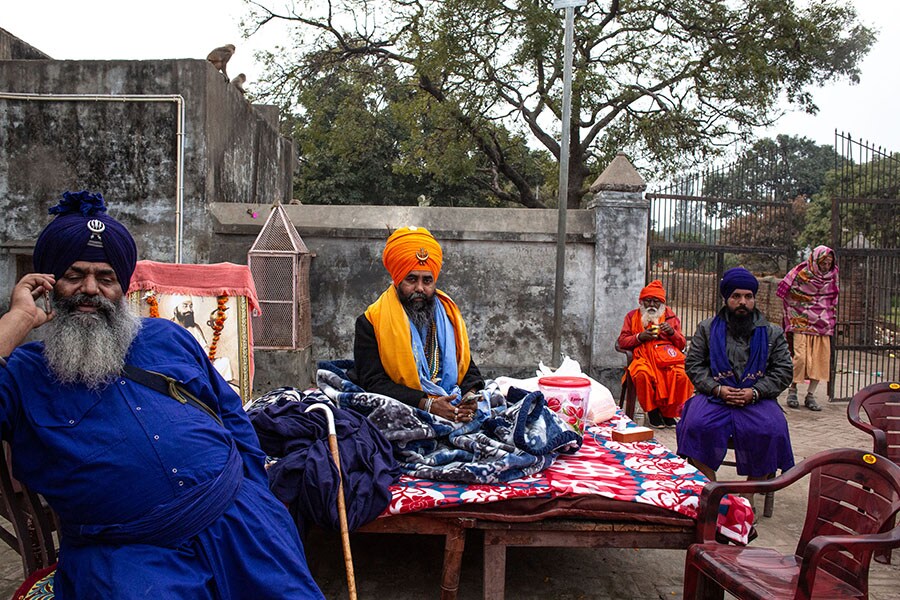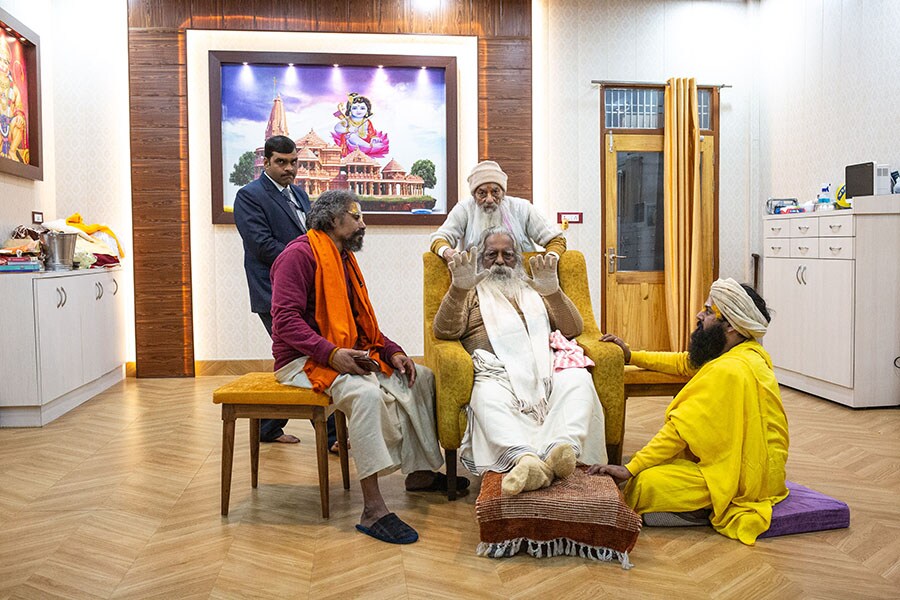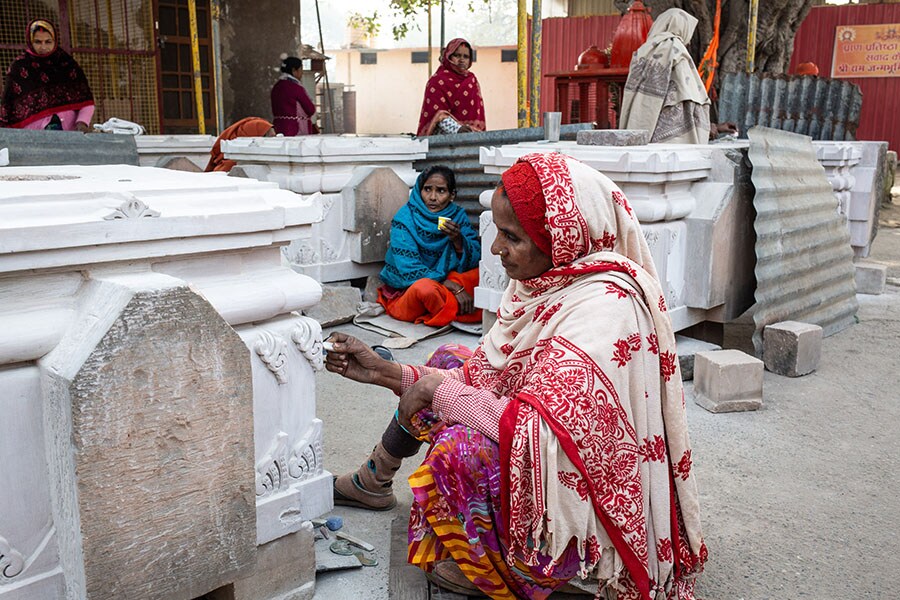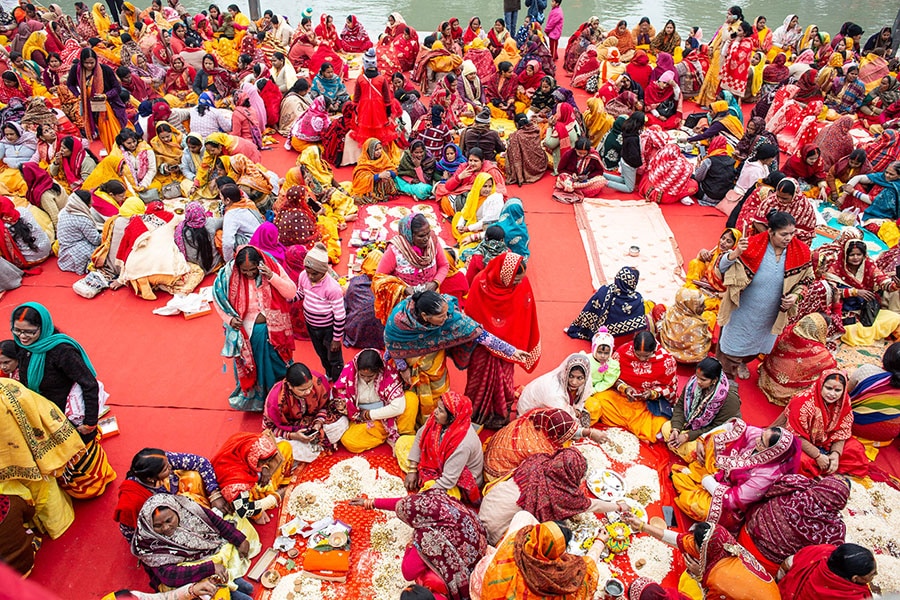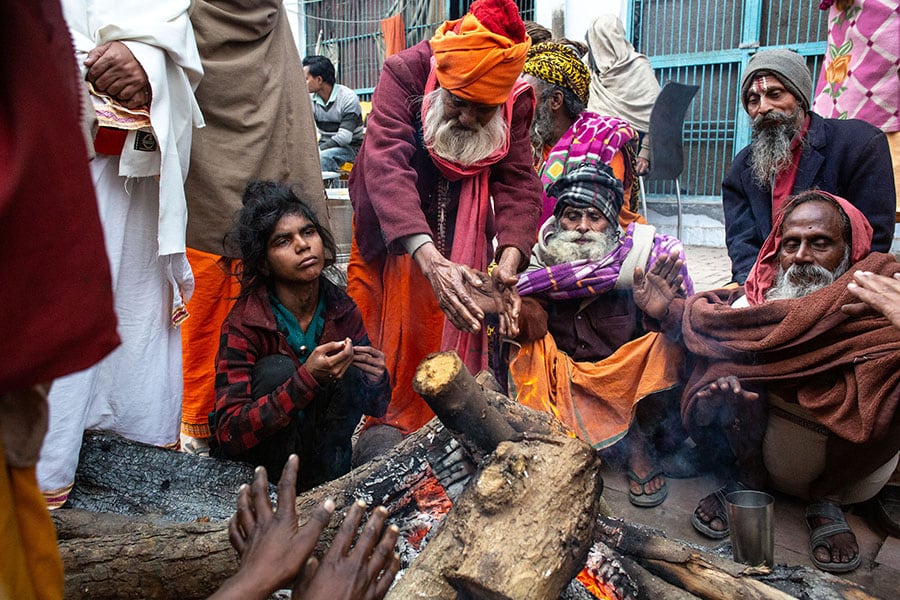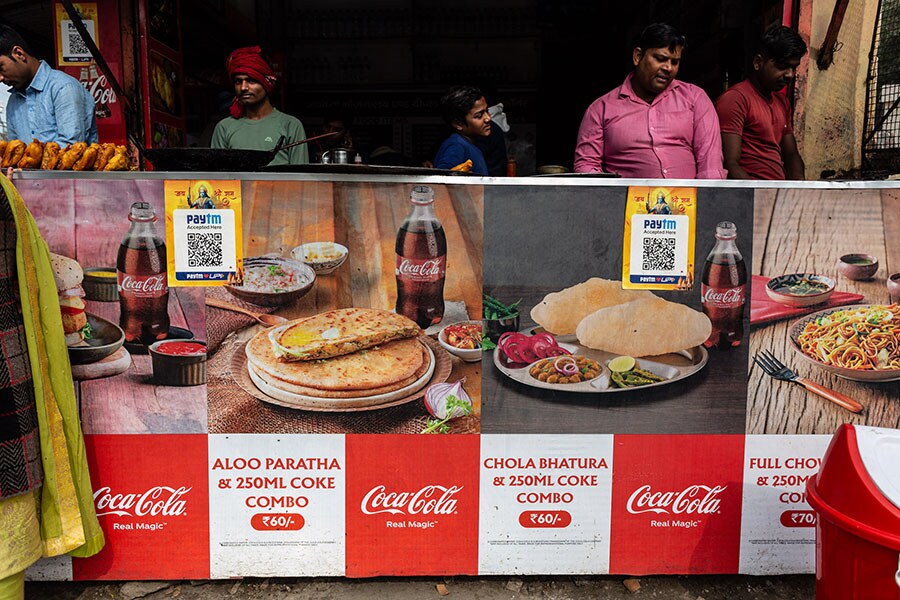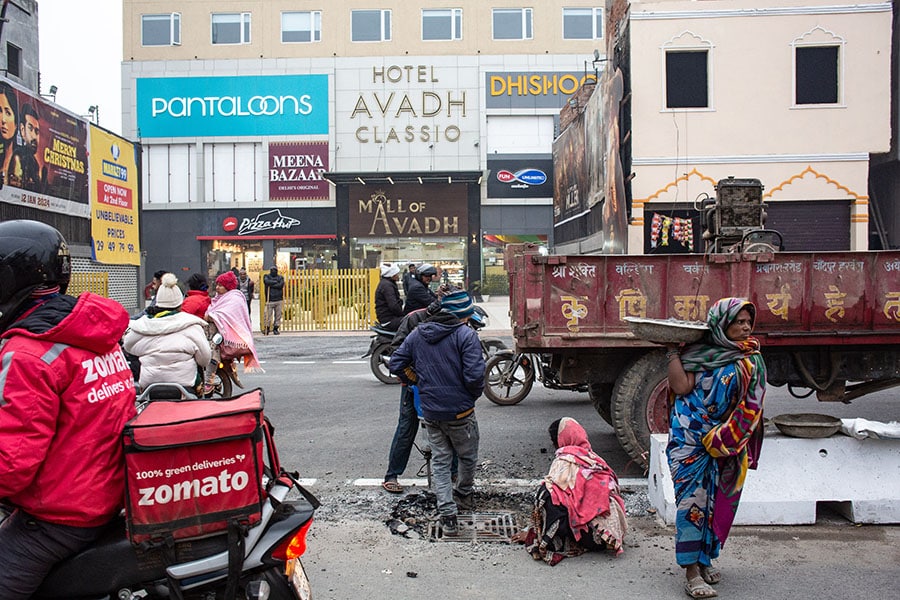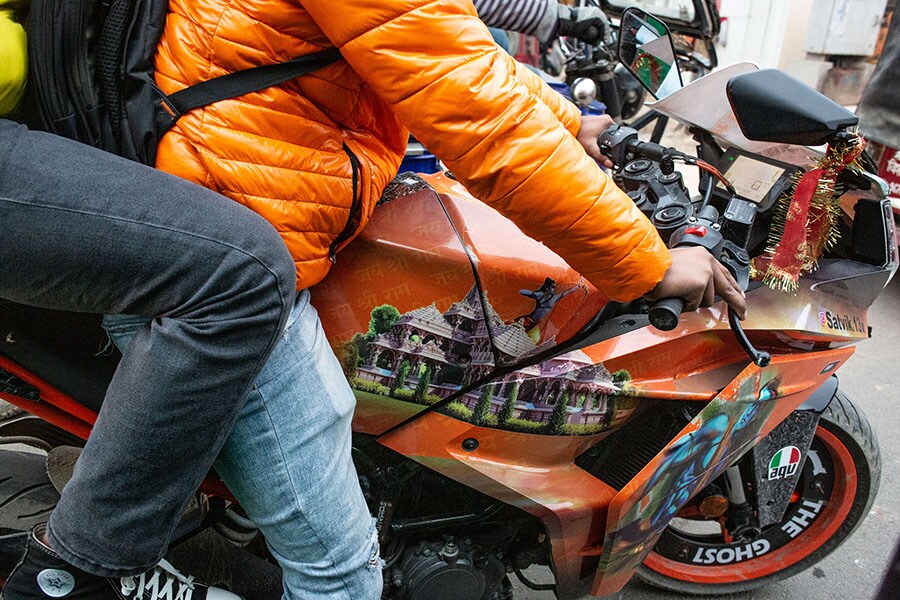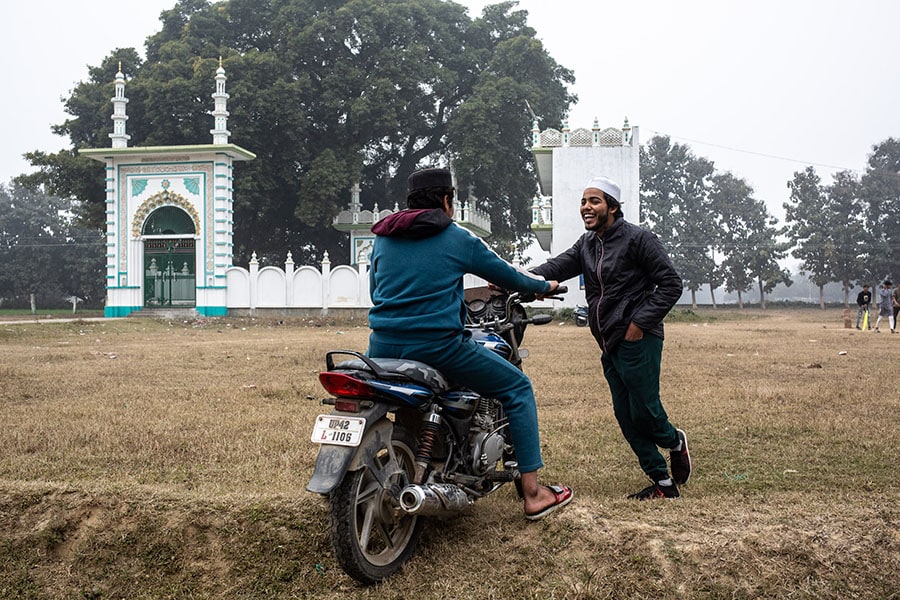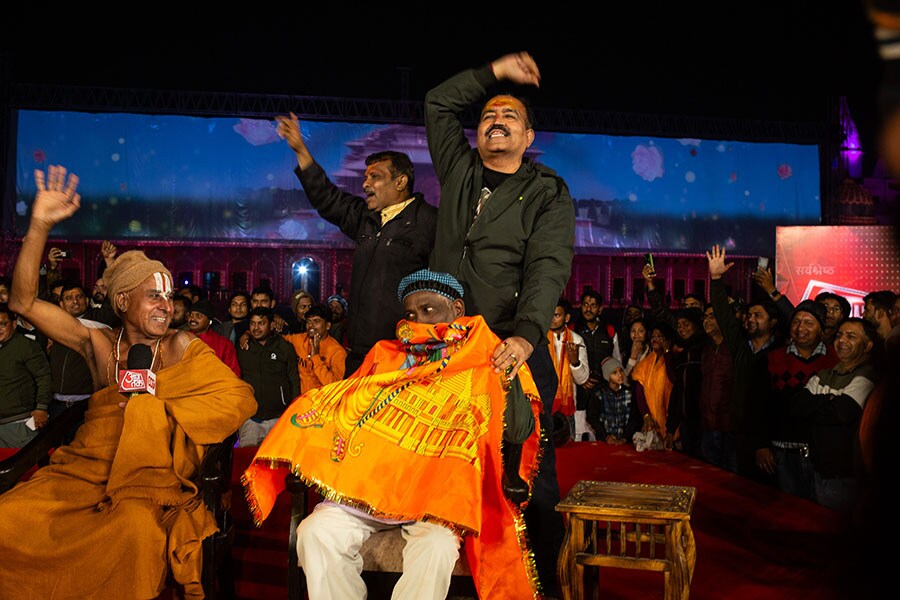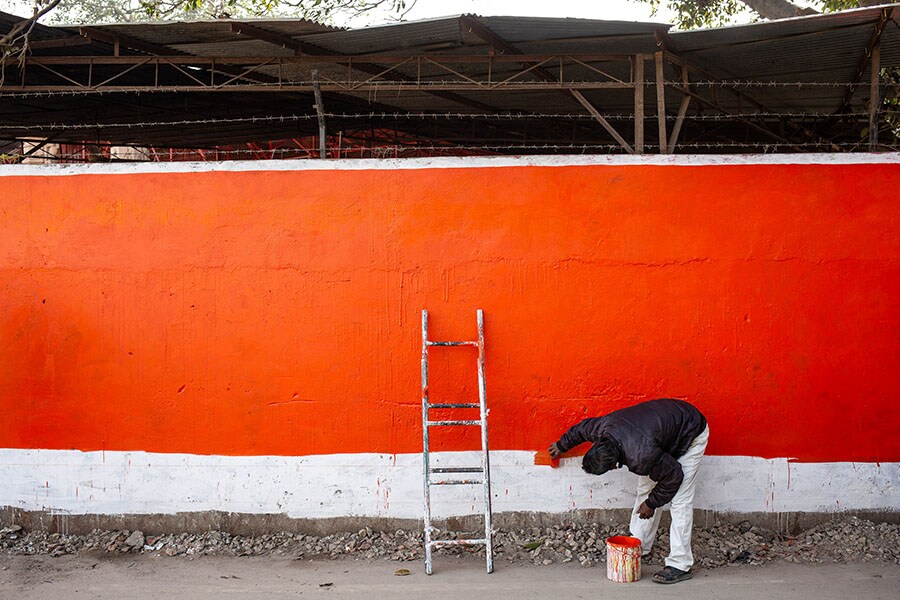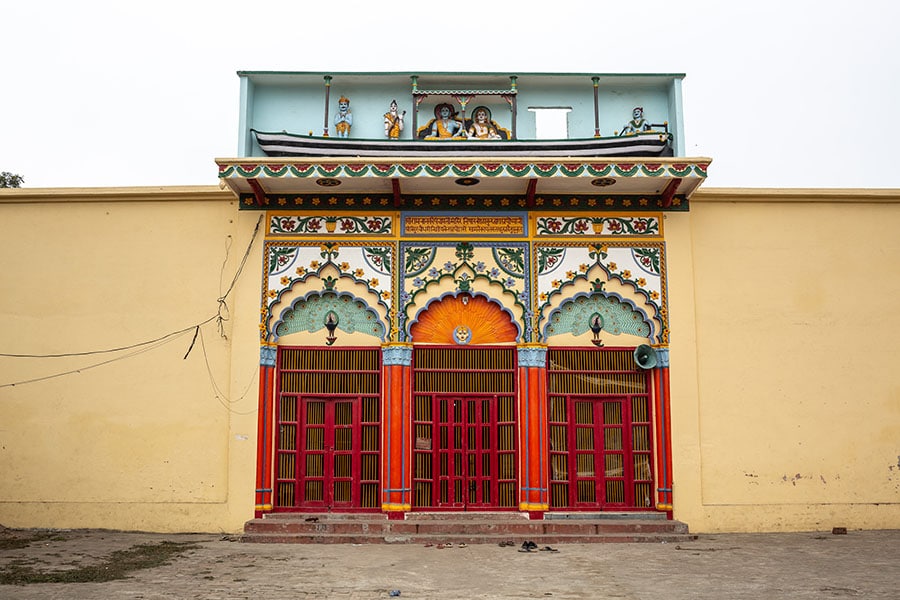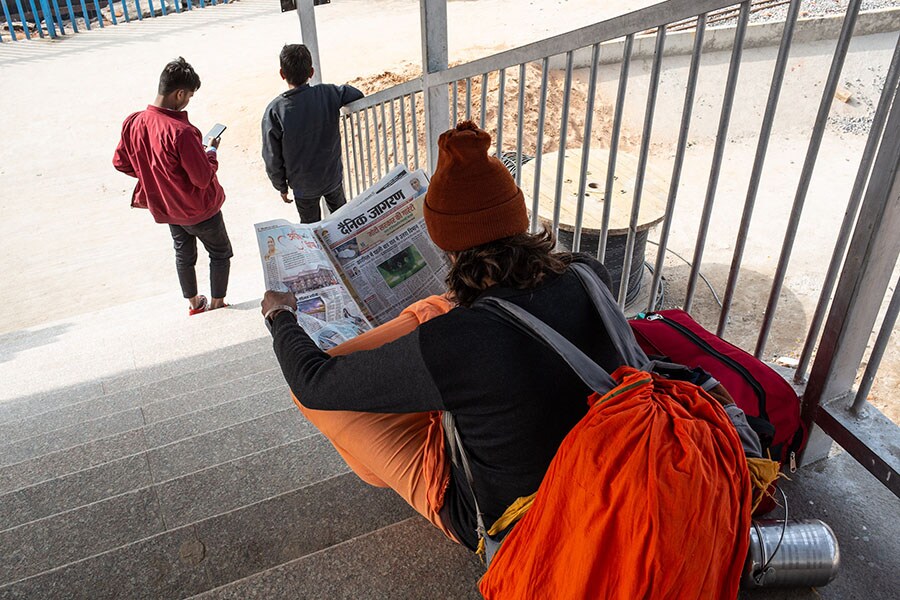Taking the form of Hanuman, the monkey God, Baba Tarkeshwar Nath steps out from a procession at Ram Mandir, Ayodhya, on January 17, 2024. Hailing from Gopalganj in Bihar, Nath has been roaming around as Hanuman for twelve years. He recalls the day the monkey God entered his body at Hanuman Garhi temple and asked him to dedicate his life "in service to Ram."
Workers cement the dome of the Ram Mandir in Ayodhya a week before the consecration of the temple to the world. The establishment of the Mandir, at an estimated cost of Rs1,800 crore to house a God who has been under a tent in a makeshift temple at Rama’s birthplace in Ayodhya— after decades of political, street, academic and legal battles —has led to a collective feeling of triumph among many Indian Hindus.
Step away from the clamour of the new temple, and the ancient town is littered with temples housing families or renunciates who live in them. Each of these temples, alive and evocative in atmosphere but in various states of architectural decay, opens inward into an open-to-sky courtyard and a sanctorum featuring Ram, Lakshman and Sita.
Sumithra ferries pilgrims in the newly introduced ETO e-rikshaws from the Ayodhya Cantt railway station to the temple, a distance of eight km. ETO Motors is partnering with Uber in this initiative. Many women drivers like Sumithra, who are employed by Delhi Transport Corporation, have been deputed here until local drivers are trained to take over.
Against the backdrop of a new multi-level parking and hospitality centre, students from Awadh University"s fine arts program draw rangoli on the newly laid roads to beautify the 8 km stretch of the main thoroughfare Ram Path near the Ram Temple.
![]()
A view of the completely refurbished Ayodhya Dham railway station in the midst of a flurry of preparations to handle increased traffic after the consecration on January 22. More than 2.5 crore people are expected to visit the temple in the next two months.
![]()
A view of the Shree Maharshi Valmiki International Airport in Ayodhya. Built at a cost of Rs1,463 crores, the first phase of the airport has been completed, featuring a terminal spanning 65,000 sq feet with a capacity of two to three flights per hour. It can currently accommodate larger aircraft like Boeing 737 and Airbus 320.
![]()
Contract construction workers try out factory seconds garments on sale during their midday break. A sleepy town until 2019, a great rush to complete infrastructure projects, including a sewerage system, is in the final stages, even as Ayodhya is rapidly growing into a city that must cope with lakhs of visitors in a day.
![]()
Purushottam Dubey heads back to his gurukul, Shri Sant Gopal Mandapam at dusk. He has been studying SriRamCharitmanas for the last five years. “This is Kalyug, yet there is a discussion on the avatar (an incarnation or embodiment in human form ) even today", he says.
![]()
Rampriya Rai looks for a space to park his cycle at Maharaja Intercollage at Mathgarh Chauraha. He wants to complete his B.Com but has set his sights on starting a guesthouse. With the authorities’ goal to turn Ayodhya into the spiritual capital of the world, the demand for visitor accommodation is going to skyrocket.
![]()
A view of the The Park Inn unveiled by Radisson Group in Ayodhya Cantt. The only luxury hotel in Ayodhya so far for the Ayodhya-bound tourist, the hospitality sector is planning hotels to meet demand, with reputed chains like the Taj Group, Marriott International and IHCL having signed deals for hotels here.
![]()
A view of the premium accommodation in Praveg Tent City, a stone’s throw away from the Temple, which is booked up for the next three months.
![]()
Sumer Baba enters Ayodhya and prostrates all the way on his two-month journey from Hardoi, Uttar Pradesh, at a distance of 270 km. His disciple, Guddu Baba, follows him, pushing a cycle carrying their necessities through the journey.
![]()
The seat at Teen Kalash Tiwari Mandir, the temple and home of the BJP’s Girish Pati Tripathi, the priest and Mayor of Ayodhya. Tripathi, a 49-year-old graduate of Defence Studies from the University of Allahabad, took after his father, who played an active role in the Ram Janmabhoomi movement.
![]()
Baba Harjeet Singh Rasulpur and his group of Nihang Sikhs camp at the Shri Char Dham Mandir in Ayodhya to run a two-month ‘Langar sewa’ (community kitchen) for the pilgrims. Harjit Singh said the ‘sewa’ is a tribute to the struggle launched by his ancestor, Baba Fakir Singh Khalsa, for the construction of the Ram temple in Ayodhya.
![]()
Devotees and pilgrims arrive every evening to get a darshan of Nritya Gopal Das Ji, the head of Sri Ram Janmabhoomi Teerth Kshetra Trust and mahant of Shri Char Dham Temple in Ayodhya.
![]()
Pilgrims avail of a free tea and biscuit service provided by sewaks under a cutout of Prime Minister Narendra Modi on Ram Path in Ayodhya. There is a clear divide between these pilgrims and the Ayodhya-bound tourists to come. These pilgrims, numbering thousands who have always arrived in buses and trains, live simply and eat food offered in the form of prasad, an experience the city has traditionally offered as its essence.
![]()
Hema Malini, actress and BJP member of the Lok Sabha plays the role of Sita onstage in Ramayan, a dance ballet performance of the epic at Amrut Mahotsav in Ayodhya.
![]()
45-year-old Aarti Devi was a safai karamchari when “Ram Lalla was in a tent". She is now part of a 25-member women’s team at the Karyashala, polishing the marble all day that forms the foundation of temple pillars, which she calls ‘God’s work’. A mother of six children, Aarti is the sole breadwinner of her family after her husband was felled by a stroke six years ago.
![]()
Local women converge at the Ram Ki Paudi to perform Avsan maiyya (durduriya) pujan before the consecration of Ram Lalla in the temple.
![]()
A destitute woman finds refuge among sadhus warming themselves over a bonfire on a cold evening in Ayodhya.
![]()
A wooden replica of the Ram temple is on sale in many of the newly renovated shops around the temple. The replicas, of varying sizes, have generated a Rs400 crore business for Saharanpur’s Muslim wood carving artisans.,
![]()
Coca-Cola’s marketers are drawing in small eateries by offering combo plans of Coke with traditional Indian food items like Chole Bhature, hoping to replace tea, the usual choice.
![]()
Brands, tarred roads and drainage are a new sight in a town that was known for its dusty lanes snaking between timeworn houses, temples and dharamshalas.
![]()
A young biker shows off his pride on the roads of Ayodhya.
![]()
Shahid Mirza pushes his friend’s bike playfully on the land allotted for a mosque in Dhannipur, Ayodhya. He studied at the Cambrian School nearby and isn’t interested in the question of when the mosque will come up. Shahid says he’s more interested in a horse race mela that happens here every year. His family owns nearly forty horses.
![]()
Iqbal Ansari (centre)—the son of late Hashim Ansari, one of the original litigants of the Ayodhya title suit—is swamped with a saffron flag by the audience at the end of a programme at Ram Ki Paudi, Ayodhya.
![]()
A severe cold morning causes a monkey to drop its wariness and join two pilgrims warming themselves over a fire ember outside Tiwari Mandir, Ayodhya.
![]()
A wash of orange before lettering an advertisement by Bank of Baroda welcoming pilgrims to Ayodhya on the walls of the Karyashala at Kar Sewak Puram.
![]()
Maharishi Valmiki, the legendary poet and author of the epic Ramayana, is flanked by Luv and Kush, the sons of Rama and Sita, at the temple dedicated to him in Chotti Chawni, Ayodhya. The verses from the Ramayana are carved in every inch of the inner walls of the temple
![]()
The detail of a boat in the facade of Nishad mandir features Ram, Sita and Lakshman sailing with Nishadraj Guha, the Nishad community’s King (on the extreme left). An episode in the Ramayana establishes the importance of this boatmen community of Adivasis (original inhabitants)
![]()
Software engineer Shailendra and his daughter Tanisha are from the Nishad community. He lives in Ayodhya and currently works from home for Infosys Hyderabad. Coming from a family of boatmen, Shailendra says his parents’ motivation to move away from their traditional profession and educate themselves caused a social upheaval in his life.
![]()
Sadhu Ramdas reads the local Hindi daily on the stairs at the Ayodhya Dham railway station. To understand what it means to bring about such upheavals to a town known to be a temporary spiritual respite for a simple pilgrim, he says one must “Give up everything, and stick to nobody or to no place, for too long."

